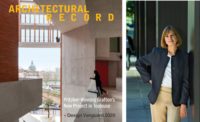As communities across the United States and the world begin to reopen after pandemic lockdowns, planners and architects are looking ahead to how we can safely work and move about in cities in this uncertain period before a coronavirus vaccine becomes widely available.
One of the most intriguing responses, well under way, is the closing of miles and miles of streets to automobiles. With traffic all but gone, and clean skies soaring overhead, cities from Oakland, California, to Berlin have opened up vast swaths of roadways to pedestrians and cyclists only. There are immediate practical reasons: many city sidewalks tend to be too narrow for social distancing, and there’s been a demand for more public space, as parks become crowded and cooped-up residents need room to walk or jog.
But the longer-term benefits to the health of both humans and the planet are obvious too, as carbon emissions and dirty air have radically decreased with much of the world’s population housebound. In Paris, Mayor Anne Hidalgo, who has long campaigned against traffic congestion, declared that the City of Light would never return to heavy car use post-pandemic. “Pollution joined up with coronavirus is a particularly dangerous cocktail,” she said. Indeed, a Harvard study has suggested a link between long-term exposure to air pollutants and death from the virus (even as the U.S. government rolls back clean-air regulations).
One major unknown is how many people—particularly in America—will give up their cars in the near future to walk, bike, or use public transit, especially with fears of crowded subway cars and buses. And will most street closures become permanent, or will those roads reopen to vehicles?
And how many people, now working from home, will be commuting to work again? A number of architecture firms, such as Gensler, Perkins and Will, and HGA, are busy advising clients on adapting office space to the new normal, despite the stark reality that a multitude of white-collar workers will probably never return to their old desks full-time. Still, barriers between workstations and conference rooms arranged for just a few people—with the rest joining meetings remotely—are among the simpler social-distancing strategies that companies are putting in place now. Planners are also suggesting HVAC upgrades to reduce the risk of infection via air circulation. And offices should be adapted to accommodate some staff, some of the time, to keep a creative culture alive. Clients of SOM, for example, “have embraced collaborative or shared semi-public spaces,” says a firm director, Julia Murphy, allowing “different business segments to cross-pollinate. That won’t go away.”
Similarly, shops and restaurants are figuring out how to reopen to attract the confidence of customers. Last month, MASS Design Group released strategic guidelines for restaurants, proposing flexible spaces and table configurations as well as sanitation measures (it is one of a series of open-source documents on the firm’s website that address safety for different building types). As summer approaches, the expansion of outdoor dining—aided by all those urban street closures—could make more American neighborhoods look a little like Paris.
In this, our annual issue of record devoted to interiors, we are looking to the future with several well-crafted new projects, including two restaurants—one by Bates Masi + Architects in New York and another in Bentonville, Arkansas, by Marlon Blackwell Architects—that, by press time, remained closed or partly closed but are expected to reopen fully soon.
Especially sad, however, is the spectacular stage set, designed by Barkow Leibinger for Beethoven’s Fidelio installed in the empty Theater an der Wien: it ended up only as a production for television, filmed days before the opening—which never happened. (You can watch it on YouTube.)
One more nod to the future is the issue of record you are holding in your hands or reading online. That’s because we have a contemporary new look: a cleaner, more readable design undertaken by the magazine’s art director, Mike Powell, in close collaboration with the editors. We hope you enjoy it, whether you’re still sheltering in place, or beginning to venture out into the world once more.





Post a comment to this article
Report Abusive Comment